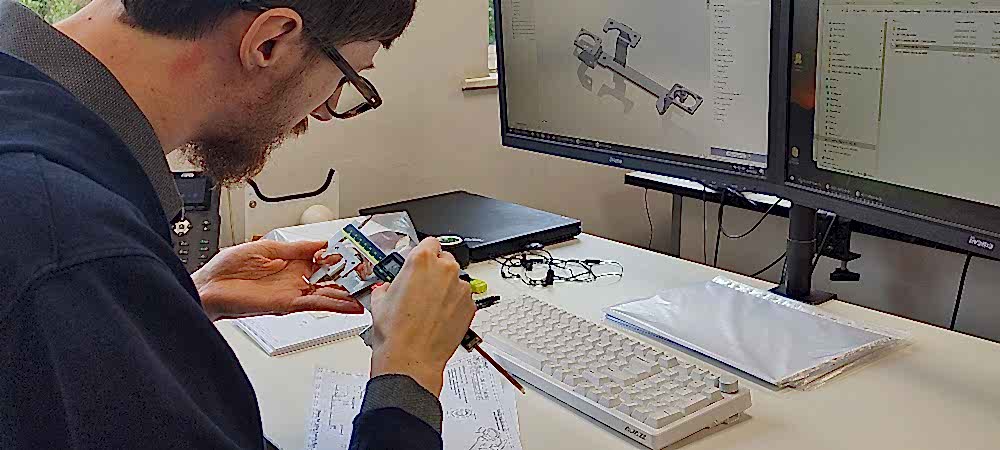When it comes to sheet metal fabrication, the difference between a smooth, cost-effective production run and costly delays or rework often lies in the early design decisions. Implementing a Design for Manufacture (DFM) approach ensures your product is not only functional but also optimised for efficient, high-quality fabrication.
At JC Metalworks, we’ve seen countless projects succeed—or struggle—based on the attention given to manufacturability during the design phase. To help engineers, product designers, and procurement managers avoid costly mistakes, we’ve put together this comprehensive DfM checklist focused on sheet metal projects.
Why Is DFM Important for Sheet Metal Fabrication?
Sheet metal fabrication involves processes like cutting, bending, welding, and finishing, each with its own limitations and cost implications. If your design doesn’t account for these realities, you risk:
- Increased material waste
- Complex or impossible bends
- Parts that don’t fit or assemble correctly
- Excessive lead times
- Higher production costs
Following DfM principles early minimizes these risks and improves the likelihood of delivering on time and budget.
1. Minimum Bend Radius Rules
One of the most critical design considerations in sheet metal is the bend radius—the inside radius of a bend.
Why It Matters:
If your bend radius is too tight, the material can crack or deform, weakening the part and leading to scrap. Too large a radius may impact assembly or aesthetics.
JC Metalworks, the UK’s leading sheet metal fabricator, provides the following standard recommendations:
- For mild steel, the minimum inside bend radius should be equal to the material thickness (1× thickness).
- For aluminium, which is less ductile, the minimum inside bend radius should be at least 1.5× the thickness.
- Stainless steel requires special consideration, often a minimum radius of 2× thickness to prevent cracking.
Additional Tips:
- Use larger radii where possible to reduce stress.
- Avoid bending near holes or cutouts to prevent deformation.
- Remember that thicker materials require larger bend radii.
2. Tolerance Recommendations
Tolerances define the allowable variation in part dimensions and directly affect fit, function, and cost in precision sheet metal manufacturing
| Feature | Typical Tolerance |
|---|---|
| Flat dimensions | ±0.5 mm (depends on size) |
| Hole locations | ±0.2 mm |
| Bend angle | ±1° |
| Thickness | Material dependent |
Design Tips:
- Specify looser tolerances where tight precision isn’t necessary to reduce cost.
- Avoid stacking tight tolerances on multiple features—it compounds cost and manufacturing difficulty.
- Communicate clearly if critical features require tighter control, like mounting holes or sealing surfaces.

3. Material Selection Tips
Choosing the right material upfront affects cost, manufacturability, strength, and corrosion resistance.
| Material | Thickness Range | Pros | Cons | Typical Use Cases |
|---|---|---|---|---|
| Mild Steel | 0.5–6 mm | Cost-effective, strong | Prone to corrosion without coating | Structural parts, frames |
| Stainless Steel | 0.5–6 mm | Corrosion-resistant | More expensive, harder to form | Food, medical, outdoor use |
| Aluminium | 0.5–6 mm | Lightweight, corrosion-resistant | Lower strength, prone to scratching | Aerospace, transport, electronics |
Design Considerations:
- Select material based on strength and environment (e.g., corrosion).
- Consider surface finish requirements (e.g., powder coating, anodising).
- Thinner gauges reduce weight and cost but may affect rigidity.

4. Hole Spacing Guidelines
Hole placement in sheet metal affects structural integrity and ease of fabrication.
Best Practices:
- Maintain a minimum distance of 2× material thickness between holes and between holes and edges to prevent cracking.
- Avoid placing holes too close to bends or weld seams.
- Use standard hole sizes compatible with common tooling to save cost and reduce lead time.
- Consider countersinking or counterboring if flush mounting is required.
5. Common Design Errors to Avoid in sheet metal fabrication projects
Designing for sheet metal fabrication requires a balance between creativity and practicality. Many costly issues can be avoided by steering clear of common pitfalls that affect manufacturability, cost, and part quality. Here are five frequent design errors to watch out for:
5.1 Ignoring Bend Reliefs
What are bend reliefs?
Bend reliefs are small cutouts or notches placed at the ends of bends, especially near cutouts, holes, or sharp inside corners.
Why they matter:
When bending sheet metal near these features, the material experiences stress concentrations that can cause tearing or cracking if there’s no relief to allow the metal to stretch and compress naturally.
Consequences of ignoring bend reliefs:
- Cracks or splits at corners during bending, leading to part failure or scrap.
- Distortion of critical dimensions near bends.
- Increased rework and delays in production.
Design tip:
Always add bend reliefs—typically small semicircular or rectangular cutouts—near sharp corners and cutouts adjacent to bends. Their size depends on material thickness but should be large enough to relieve stress without weakening the part.
5.2 Unrealistic Tolerances
What does this mean?
Tolerances define the acceptable range of dimensional variation. Unrealistic tolerances are those that are tighter than necessary for the function of the part.
Why it’s a problem:
- Tight tolerances require more precise tooling, longer setup times, and increased inspection, driving up costs.
- They can cause higher rejection rates if the manufacturing process cannot reliably meet these tolerances.
- Over-specifying tolerances can unnecessarily slow down production.
Consequences:
- Higher manufacturing costs and longer lead times.
- Potential supply chain bottlenecks due to rework or scrap.
- Strain on relationships between designer and manufacturer.
Design tip:
Specify tolerances only as tight as required for the part’s function. Consult your fabricator to understand what tolerances are standard and achievable for the chosen materials and processes.
5.3 Overcomplex Geometry
What qualifies as overcomplex geometry?
Designs with intricate shapes, small features, excessive curves, or complex bends that are difficult to fabricate or require multiple setups.
Why it matters:
- Complex parts often need specialized tooling or multiple manufacturing steps.
- They increase the risk of errors, defects, and inconsistencies.
- Fabrication and assembly times grow, raising costs.
Consequences:
- Increased lead times and tooling expenses.
- Higher scrap rates and quality issues.
- Difficulties in scaling up production or making design changes.
Design tip:
Simplify geometry where possible. Use standard bend angles, minimize small or tight features, and avoid unnecessary complexity that does not add functional value. Collaborate early with your fabricator to identify and optimize complex areas.
5.4 No Consideration for Assembly
What does this involve?
Designing parts in isolation without planning how they will fit, align, or fasten together during final assembly.
Why it’s a problem:
- Parts may not align correctly, leading to assembly difficulties or failure.
- Additional fixtures, jigs, or manual adjustments may be needed, increasing labor.
- Assembly errors can cause costly rework or scrap.
Consequences:
- Delays in production and increased labor costs.
- Poor product quality or functionality.
- Customer dissatisfaction due to assembly defects.
Design tip:
Incorporate features that aid assembly, such as tabs, slots, alignment holes, or self-locating components. Consider accessibility for fasteners or welds and provide clear assembly instructions if necessary.
5.5 Neglecting Material Grain Direction
What is material grain direction?
Metal sheets have a grain direction resulting from the rolling process, which affects how the metal bends and stretches.
Why it matters:
- Bending along the grain allows smoother deformation.
- Bending against the grain increases the risk of cracking or splitting, especially in brittle or thicker materials.
Consequences:
- Cracks or fractures along bends.
- Inconsistent bend quality and strength.
- Potential failure in service.
Design tip:
Always identify and align bends to run parallel to the grain direction where possible. Work with your fabricator to determine grain orientation on supplied sheets and adjust the design or layout accordingly.
Avoiding these common design errors will not only save time and money but also improve the reliability and quality of your sheet metal parts. At JC Metalworks, we encourage early collaboration during the design phase to catch and correct these issues, ensuring a smooth, cost-effective manufacturing process.
Tips for Optimising Your Sheet Metal Design
Optimising your sheet metal design goes beyond the basic DfM rules. Incorporating these additional best practices will further enhance manufacturability, reduce production costs, and improve the quality and functionality of your parts.
1. Use Uniform Wall Thickness to Avoid Uneven Stresses
Maintaining a consistent thickness throughout your sheet metal part is key to ensuring structural integrity and predictable behavior during fabrication.
- Why it matters: Variations in wall thickness cause uneven stresses during bending, welding, or forming. Thinner sections may warp or deform, while thicker areas resist bending, leading to cracks or distortion.
- Impact on production: Non-uniform thickness can lead to unpredictable spring-back (the metal’s tendency to slightly “unbend” after forming), increasing the risk of out-of-tolerance parts.
- Design tip: If multiple thicknesses are needed for functional reasons, try to transition between thicknesses gradually or through separate parts to avoid stress concentrations.
2. Minimise the Number of Different Material Thicknesses to Reduce Tooling Changes
Using several different sheet metal thicknesses within one project might seem beneficial for performance but can significantly increase manufacturing complexity and cost.
- Why it matters: Different thicknesses often require different tooling settings or even different press brakes, which leads to longer setup times and higher tooling costs.
- Impact on cost and lead time: Each thickness change can cause downtime as the manufacturer adjusts machines, affecting both your timeline and budget.
- Design tip: Standardise material thickness across components wherever possible. If different thicknesses are essential, group parts by thickness for batch production to optimise efficiency.
3. Design for Standard Sheet Sizes to Reduce Scrap
Sheet metal is usually supplied in standard sheet sizes (e.g., 4’ x 8’, 5’ x 10’). Designing parts that fit efficiently within these standard dimensions minimises material waste and lowers raw material costs.
- Why it matters: Custom or oversized parts that don’t nest well on a sheet lead to larger offcuts and scrap.
- Impact on sustainability and cost: Less scrap means more cost-effective production and a smaller environmental footprint.
- Design tip: Work closely with your fabricator to understand their sheet sizes and nesting capabilities. Use CAD nesting software if possible to optimise the layout and reduce scrap before production.
4. Use Tab and Slot Features to Simplify Assembly
Tabs and slots are interlocking features designed into sheet metal parts that allow for easy alignment and assembly without requiring extra fixtures or complex jigs.
- Why it matters: These features reduce assembly time and improve accuracy by mechanically guiding parts into place.
- Impact on assembly: Faster assembly translates to lower labor costs and fewer errors.
- Design tip: Ensure tabs are slightly smaller than slots to allow for easy fit but tight enough to hold parts securely. Consider adding small reliefs near tabs and slots to prevent stress concentration during bending.
Incorporating these bonus tips into your sheet metal design will help you create parts that are not only functional but also optimised for efficient, cost-effective production. These considerations lead to fewer production issues, better-quality parts, and faster turnaround times—all critical in today’s competitive manufacturing landscape.
Conclusion
Applying this DfM checklist will save you time, reduce costs, and improve part quality in your next sheet metal project. At JC Metalworks, we’re always happy to collaborate early in your design process to offer practical advice and manufacturability feedback.Got a sheet metal project in design? Contact our team today for a free consultation — let’s get your design right the first time.





